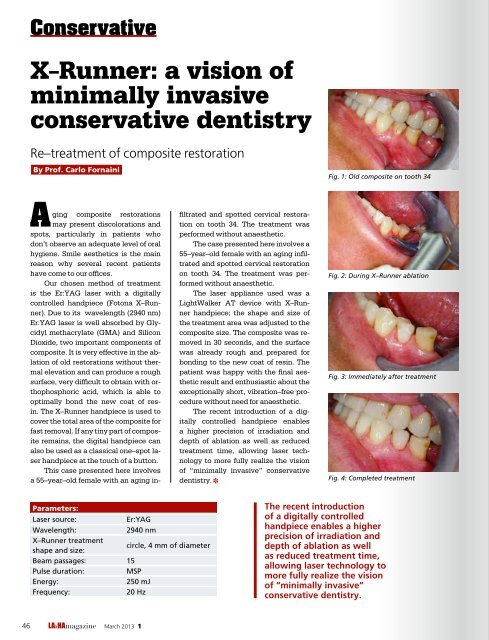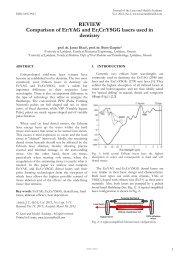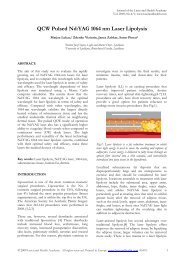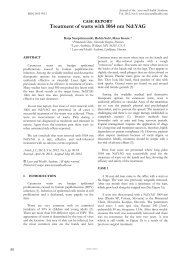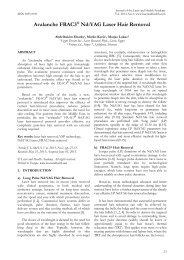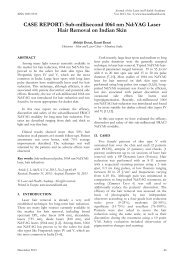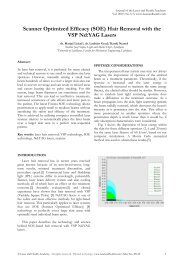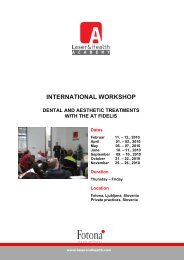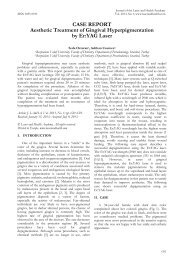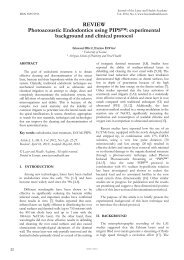LA&HA Magazine, Vol 2013, Issue 01 - Laser and Health Academy
LA&HA Magazine, Vol 2013, Issue 01 - Laser and Health Academy
LA&HA Magazine, Vol 2013, Issue 01 - Laser and Health Academy
You also want an ePaper? Increase the reach of your titles
YUMPU automatically turns print PDFs into web optimized ePapers that Google loves.
Conservative<br />
X–Runner: a vision of<br />
minimally invasive<br />
conservative dentistry<br />
Veneer bonding:<br />
the attraction is now mutual<br />
By Dr. Evgeniy Mironov<br />
Re–treatment of composite restoration<br />
By Prof. Carlo Fornaini<br />
Aging composite restorations<br />
may present discolorations <strong>and</strong><br />
spots, particularly in patients who<br />
don’t observe an adequate level of oral<br />
hygiene. Smile aesthetics is the main<br />
reason why several recent patients<br />
have come to our offices.<br />
Our chosen method of treatment<br />
is the Er:YAG laser with a digitally<br />
controlled h<strong>and</strong>piece (Fotona X–Runner).<br />
Due to its wavelength (2940 nm)<br />
Er:YAG laser is well absorbed by Glycidyl<br />
methacrylate (GMA) <strong>and</strong> Silicon<br />
Dioxide, two important components of<br />
composite. It is very effective in the ablation<br />
of old restorations without thermal<br />
elevation <strong>and</strong> can produce a rough<br />
surface, very difficult to obtain with orthophosphoric<br />
acid, which is able to<br />
optimally bond the new coat of resin.<br />
The X–Runner h<strong>and</strong>piece is used to<br />
cover the total area of the composite for<br />
fast removal. If any tiny part of composite<br />
remains, the digital h<strong>and</strong>piece can<br />
also be used as a classical one–spot laser<br />
h<strong>and</strong>piece at the touch of a button.<br />
This case presented here involves<br />
a 55–year–old female with an aging in-<br />
filtrated <strong>and</strong> spotted cervical restoration<br />
on tooth 34. The treatment was<br />
performed without anaesthetic.<br />
The case presented here involves a<br />
55–year–old female with an aging infiltrated<br />
<strong>and</strong> spotted cervical restoration<br />
on tooth 34. The treatment was performed<br />
without anaesthetic.<br />
The laser appliance used was a<br />
LightWalker AT device with X–Runner<br />
h<strong>and</strong>piece; the shape <strong>and</strong> size of<br />
the treatment area was adjusted to the<br />
composite size. The composite was removed<br />
in 30 seconds, <strong>and</strong> the surface<br />
was already rough <strong>and</strong> prepared for<br />
bonding to the new coat of resin. The<br />
patient was happy with the final aesthetic<br />
result <strong>and</strong> enthusiastic about the<br />
exceptionally short, vibration–free procedure<br />
without need for anaesthetic.<br />
The recent introduction of a digitally<br />
controlled h<strong>and</strong>piece enables<br />
a higher precision of irradiation <strong>and</strong><br />
depth of ablation as well as reduced<br />
treatment time, allowing laser technology<br />
to more fully realize the vision<br />
of “minimally invasive” conservative<br />
dentistry. A<br />
Fig. 1: Old composite on tooth 34<br />
Fig. 2: During X–Runner ablation<br />
Fig. 3: Immediately after treatment<br />
Fig. 4: Completed treatment<br />
Fotona’s LightWalker AT makes<br />
veneer bonding a br<strong>and</strong> new experience<br />
<strong>and</strong> takes the procedure onto<br />
a whole new level, both for a dentist as<br />
well as the patient. It’s now as clean,<br />
fast, precise <strong>and</strong> painless as can possibly<br />
be.<br />
A patient came to our office to improve<br />
the aesthetics of her smile. After<br />
the initial check–up <strong>and</strong> discussion of<br />
options, the patient decided to replace<br />
her 2–year old direct–made composite<br />
veneers with new ones. We made the<br />
decision to keep the enamel untouched<br />
<strong>and</strong> to work in the previous composite<br />
only.<br />
Using our Fotona LightWalker AT,<br />
we started ablation with QSP mode,<br />
150 mJ, 12 Hz — higher settings than<br />
for surface modification in enamel/dentine,<br />
because in this case we need-<br />
ed to remove more volume than in a<br />
laser surface modification procedure<br />
only. After we saw the material’s response,<br />
we raised the energy to 180<br />
mJ, while in areas with a thicker layer<br />
of the existing composite we switched<br />
over to 15 Hz. In QSP mode the effect<br />
of changing the energy or repetition<br />
rate is more notable than in MSP<br />
preparation modes — this helps us to<br />
work more quickly with the same level<br />
of precision. We went 0.3 mm into the<br />
old composite, but still had not reached<br />
After a total time of<br />
an hour <strong>and</strong> a half, the<br />
patient was satisfied<br />
with her new look <strong>and</strong><br />
felt very relaxed after<br />
the painless procedure.<br />
the enamel. The preparation was very<br />
clean <strong>and</strong> a hi–adhesive surface for<br />
adding new material was achieved.<br />
The preparation took 1.5 — 2 minutes<br />
for each of the central incisors <strong>and</strong> one<br />
minute each for the laterals.<br />
After placing the rubber dam, direct<br />
adhesive restorations were made<br />
with a layer of Gr<strong>and</strong>ioso Heavy flow<br />
(Voco) placed first to establish a strong<br />
<strong>and</strong> uniform connection between the<br />
two types of composites. A brush was<br />
used to homogenize the material. After<br />
curing the flow material, the final shaping<br />
was done with Gr<strong>and</strong>ioso B1.<br />
Finishing <strong>and</strong> polishing was performed<br />
with the Dimanto (Voco) polisher<br />
set. After a total time of an hour<br />
<strong>and</strong> a half, the patient was satisfied<br />
with her new look <strong>and</strong> felt very relaxed<br />
after the painless procedure. A<br />
Parameters:<br />
<strong>Laser</strong> source:<br />
Er:YAG<br />
Wavelength:<br />
2940 nm<br />
X–Runner treatment<br />
shape <strong>and</strong> size:<br />
circle, 4 mm of diameter<br />
Beam passages: 15<br />
Pulse duration:<br />
MSP<br />
Energy:<br />
250 mJ<br />
Frequency:<br />
20 Hz<br />
The recent introduction<br />
of a digitally controlled<br />
h<strong>and</strong>piece enables a higher<br />
precision of irradiation <strong>and</strong><br />
depth of ablation as well<br />
as reduced treatment time,<br />
allowing laser technology to<br />
more fully realize the vision<br />
of “minimally invasive”<br />
conservative dentistry.<br />
Fig. 1: Beginning of treatment<br />
Parameters:<br />
<strong>Laser</strong> source:<br />
Er:YAG<br />
Wavelength:<br />
2940 nm<br />
Pulse duration:<br />
QSP<br />
Energy:<br />
150 – 180 mJ<br />
Frequency:<br />
12 – 15 Hz<br />
H<strong>and</strong>piece:<br />
H02–C<br />
Fig. 2: After surface preparation<br />
Fig. 3: Immediately after treatment<br />
46 LA&<strong>HA</strong>magazine<br />
March <strong>2<strong>01</strong>3</strong> 1<br />
47


